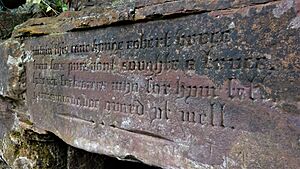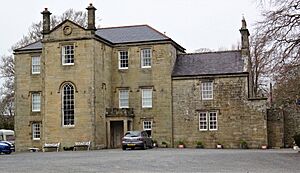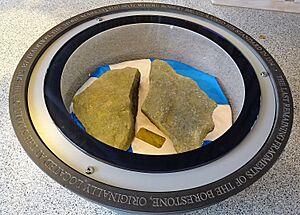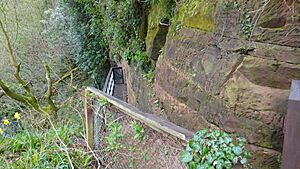Bruce's Cave facts for kids
Quick facts for kids Bruce's Cave |
|
|---|---|
| Dunskellie Grotto | |
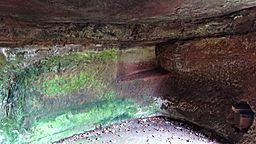
The inside of Bruce's Cave with the altar or alcove.
|
|
| Location | Kirkpatrick-Fleming, Dumfries and Galloway |
| OS grid | NY 2650 7038 |
| Elevation | 9 metres |
| Entrances | 1 |
| Difficulty | Easy |
| Hazards | Access |
| Access | Private |
Bruce's Cave, also known as the Dunskellie Grotto, is a small cave carved into red sandstone cliffs. It sits about 9 metres (30 feet) above the Kirtle Water river in Kirkpatrick-Fleming, Scotland. This cave is famous for its connection to Robert the Bruce and a well-known story about a spider.
Contents
Bruce's Cave: A Secret Hideaway
Bruce's Cave is found in a red sandstone cliff on the south side of the Kirtle Water. To reach it, you climb steps cut into the rock. There's also a platform supported by wooden beams. This pathway was built in 1927. Before that, visitors had to be lowered by ropes, which caused many accidents!
Exploring the Cave
The cave has clear tool marks, showing it was partly made by people. It's mostly round, with a small alcove that might have been an altar. The cave is about 5 metres (16 feet) wide, 4 metres (13 feet) deep, and 2 metres (6.5 feet) high. The floor slopes slightly.
You can easily spot the cave opening from the Kirtle Water. It's high enough to stay dry, even when the river floods. The entrance has been changed over time. It looks like it once had an outer door that fit flush with the rock. There might have also been inner doors. Some holes near the entrance could have been for ventilation or for large wooden supports for the platform.
How to Visit
If you want to visit Bruce's Cave, the Bruce's Cave Caravan Park charges a small fee for parking and access.
The Story of Robert the Bruce
This cave might have started as a natural hole, but it was made bigger by people. It would have been a safe place to hide valuable items during border raids or wars. As early as 1408, the area was called 'Cove' (which means 'cave' in Scots).
The legend says that Robert the Bruce hid here from English soldiers in 1306. His supporter, William Irving, supposedly brought him food and drink.
The Spider Legend
The famous saying, "If at first you don’t succeed try, try and try again", is often linked to Bruce's time in a cave. The story goes that he watched a spider trying many times to build its web. This inspired him not to give up. However, it's unlikely this specific cave was the place where that happened. Another cave on Rathlin Island is also said to be the spot for this famous event.
Dunskellie Castle and Cove House
The land around the cave became known as 'Cove'. The large house there today, Cove House, is built on or near where Dunskellie Castle once stood.
In 1907, a local historian mentioned the site as the "Cove of the Dunskelly." The link to Robert the Bruce is part of the Irving family's history. Sir William Irving was Robert the Bruce's standard-bearer at the 1314 Battle of Bannockburn.
Dunskellie Castle was owned by the Irvings, then passed to the Johnstones in the 1500s. In 1593, the castle was destroyed as punishment for a conflict. A new house was built in 1680 using stones from the old castle. Later, in 1844, Cove House was built, using parts of that older building.
Messages on the Rocks
Near the entrance path, you can see two carvings on the rock face. One is a shield with a cross and a castellated bar. The other is a five-pointed star.
Above the entrance, there's also an inscription that reads:
- "Within this cave kynge robert bruce
- from foes pursuent soughte a truce
- lyke my Forbearers who for hym fell
- j ermengarde doe guard yt well".
This inscription was made for Emma Ermengarda Ogilvy, whose family bought the Cove Estate in 1835. It was first noted in 1902.
What's in a Name?
The name 'Dunskellie' might come from the Scots Gaelic words "dun sgealaighe." This means "the fort of the teller of tales" or "romances." The word 'grotto' also suggests that the cave might have once been a hermitage. This means it could have been a home for a soothsayer or a hermit, like at St Robert's Cave in Knaresborough.


